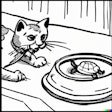
A cross-sectional, epidemiological study conducted in Finland examined the connections among pet dogs’ early life diet styles and the incidence of chronic enteropathy during later stages of their lives. In the study, University of Helsinki researchers observed that when puppies ate items like table scraps, raw bones and cartilage the likelihood of later gastrointestinal problems diminished. Their findings stands in contrast to the common advice that feeding table scraps is bad for dogs.
“We found that feeding a non-processed meat-based diet and giving the dog human meal leftovers and table scraps during puppyhood and adolescence were protective against chronic enteropathy later in life,” the scientists wrote in Nature’s Scientific Reports.
The study, based on longitudinal data and utilizing a food frequency questionnaire, analyzed the early life diet of companion dogs. The study revealed significant associations between early diet and chronic enteropathy incidence in adulthood. Feeding a non-processed or minimally processed meat-based diet (NPMD) during puppyhood (2–6 months) and adolescence (6–18 months) was associated with decreased chronic enteropathy incidence. Conversely, feeding a highly processed, carbohydrate-based diet, specifically kibble, during the same periods increased the potential for occurrence of enteropathy development later in life.
The research identified specific dietary components that played a protective role. Raw bones and cartilage, as well as berries, when included in the diet during puppyhood and adolescence, were associated with lower chronic enteropathy incidence. The protective effect of raw bones and cartilage increased with higher feeding frequencies.
Eating human meal leftovers and table scraps in early life had a significantly protective effect on the future gastrointestinal illness incidence. However, home-cooked meal diets did not have the same effect. Table scraps included cooked potato, non-sour milk products, cooked poultry and fish and processed meat.
Principal component analysis and logistic regression were employed to explore links between diet styles and owner-reported chronic enteropathy incidence.
Influence of microbial exposure on dogs’ microbiome
The research highlighted the role of the intestinal microbiome in canine chronic enteropathy. The researchers suggested that feeding NPMD may have stimulated the growth of a balanced gastrointestinal microbiome, contributing to intestinal homeostasis. The biodiversity hypothesis, suggesting more microbial exposures in early life promote a healthier immune system, was supported by the findings.
The Finnish study provided evidence that minimally processed diets during puppyhood and adolescence may help mitigate the risk of chronic enteropathy later in life. These findings underscore the need for continued research and informed decision-making in the formulation of canine diets.



















